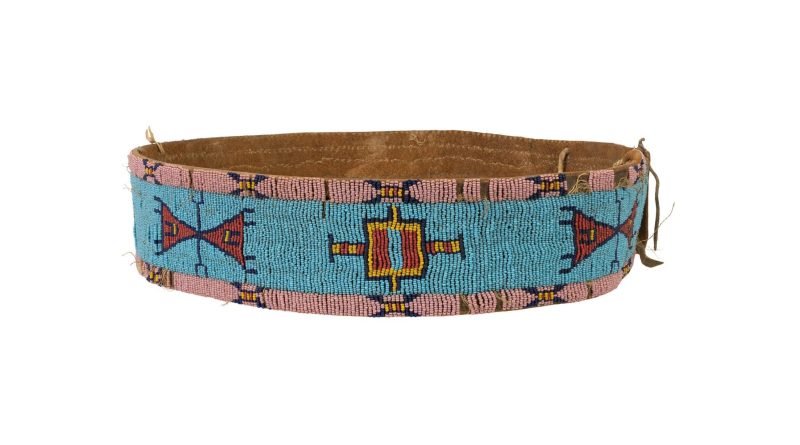Lewis & Clark Expedition – Did Sacajawea Voluntarily Donate Her Beaded Belt For a Fur Cloak?
The place and event.
Shortly after the Corps of Discovery arrived on the Pacific west coast, it was no coincidence that several tribesmen appeared before Lewis and Clark wearing excellent fur apparel. These coastal tribes were commercially savvy. They had been trading with foreign sailors for years. They also knew what was on the explorer’s minds in addition to finding a cross-country trade route.
Thus, Lewis and Clark were awestruck by a particular sea otter shoulder cloak worn by a tribesman. But, they did not have enough tradable goods on-hand to obtain it from him. The tribesman also wanted the blue-beaded belt worn by the corps interpreter’s wife, Sacajawea. Did she voluntarily give it up for that purchase?
Sacajawea’s teenage years.
About five years earlier, Sacajawea’s early teenage life underwent a tumultuous change. As a 12-year-old Lemhi Shoshone girl living near the now Idaho-Montana border, she was captured by a party of Hidatsa warriors. From there, she was taken to a large Hidatsa-Mandan dual-tribal village near the Knife and Missouri Rivers in North Dakota, where she was adopted by a Hidatsa family. The practice of capturing children from different tribes was common among the plains tribes at that time.
During the next four years in her new home, she learned the Hidatsa language and worked with the village women in their large field gardens. The Hidatsa and Mandan tribes were matriarchal matrilineal agricultural tribes. That is, the women there owned and inherited the 20-foot-across earth-covered lodges and the huge gardens they maintained.
They also headed the large clans within these tribes, while the men attended to the village defenses and hunting needs. The women of these two tribes grew so much food, which they stored underground during the winter months, they easily traded portions of it for needed goods from several nonagricultural tribes and the French and English trappers passing through the region.
During these four short pre-marriage pre-motherhood years within her new tribe, Sacagawea must have made a favorable impression on the older women there. Her adoptive mother could have been influential in their Hidatsa clan, but just how much, no one knows for sure. Still, Sacagawea was eventually awarded a blue-beaded belt by an influential society of the women there. According to tribal historians, such belts were awarded to those who were industrious and, perhaps, sensible and well-grounded. The belt itself could have been three-fingers wide, with an extended section hanging down at the point of attachment.
This belt meant a lot to Sacajawea. It meant more to her than mere success through her work. To her, this belt meant acceptance and accomplishment outside of her tribal bloodline. It was a visible token of her all-around worthiness as a person. This belt could have further inspired her to grow into a well-grounded mid-teenager. That is when she married a French-Canadian fur trader at the age of 16.
Meeting Lewis and Clark
Shortly after that, in late 1804, they met the Corps of Discovery there at their dual village, where she gave birth to a baby boy on February 11, 1805. Captain Lewis helped with the delivery. The captains also hired her trapper husband, Toussaint Charbonneau, as an interpreter. He spoke French, Hidatsa, and Mandan, and could sign. As it also turned out, Sacagawea, who spoke Hidatsa and Shoshone, accompanied him with their son on this dangerous journey. Their son was less than two months old when they departed their village for the west.
During the journey westward, Sacajawea showed substantial maturity and capability. Lewis and Clark praised her in their journals when she calmly retrieved floating goods from the river while the boat she was in began to capsize in a wind storm. She also supplied the corps with many wild edibles and thought nothing of it. Additionally, she remembered the Shoshone-country landmarks and their language well.
Thus, she helped immensely with the necessary interpretations when the corps arrived at her home tribe before crossing the Rocky Mountains. Furthermore, when the corps departed this village westward, she stayed with her fur-trapper husband to finish the journey. She and their baby son could have easily stayed there among her people now that her brother was the chief of that Shoshone tribe. Instead, she stayed with her husband and the corps.
Back to the question.
Now, back to the question: did Sacajawea voluntarily donate her belt toward the purchase of that cloak? Although it’s not known for certain, she definitely could have done so at the behest of the corps’ mission to find a trade route, which she understood. After all, she had been watching the corps collect animal and plant specimens, pelts, and skins for several months by then.
So, during that spellbinding splendid-fur-for-sale moment, she could have given Lewis and Clark the nod to add her belt to the trade package. Quietly and tearfully, perhaps? Yet, she also knew that the coastal tribes knew the corps had a vested interest in the furring industry then. That is why these tribes could demand the highly prized chieftain beads, like, the blue ones on her belt for quality pelts.
Moreover, the very next day after purchasing that fur cloak, November 21, 1805, Clark noted in his journal that they had given Sacajawea a “coat of blue cloth” to compensate her for the traded belt. That blue coat could have been a heavily adorned one of very fine cloth from a military dress uniform. To learn more about Sacagawea, see the LewisClarkandbeyond bicentennial presentations by Dr. Amy Mossett and the following sites.





